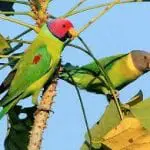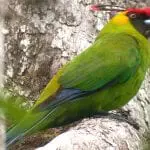Scientific Facts
| Common Name | Plain Parakeet |
| Scientific Name | Brotogeris Tirica |
| Life Span | 15 years |
| Size | 23 centimeters |
| Habitat | Trees and bushes, second-growth forests Lowland evergreen forest areas Degraded former forest areas, woodlands, Partially cultivated lands, urban areas, and parks |
| Country of Origin | Southern and Eastern Brazil |
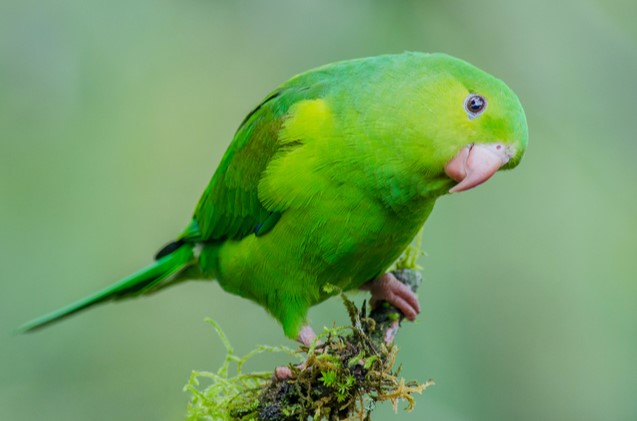
Physical Description
Adult Plain Parakeets have an average length of 23 centimeters and weigh about 65 grams. They are characterized by their very long tail. They have the longest tail that it even consumes half of the length of the body.
Some people may consider simplicity as a drawback. Many owners prefer to get birds with a glamorous combination of hues on feathers. However, that is not what the Plain Parakeet tells about. Their look may be simple and unambiguous. Getting a clue from the name itself, Plain Parakeets are not dazzlingly hued as their cousins. They have largely green plumage. Their underparts, cheeks, and crown have touches of yellow. The lesser wing feathers, as well as the shoulder, are olive-green. They also have blue-green flight feathers. The underside of the tail is also blue-green. Both primary and secondary feathers are outlined with green. They have dark brown irises. The eye-ring is dull-grey. The feet are dark-flesh, and the bill is brownish, reversing horn-colored going to the base.
The young Plain Parakeets look similar to adults aside from the wings, tail, and bill. The primary coverts of young parakeets are pure green. The primary feathers, as well the outer secondary feathers, are hued with blue. They have a shorter tail, and their upper beak is hued with brown in the base.
Nonetheless, their charming look is indisputable. Both male and female adults are completely green. In reality, the severity of this green tint differs and wavers throughout the body, and demonstrates an impressive variation, knowing that it is a single color. Do not be discouraged by its plain look. Although these creatures are plain, they still have plenty of appeals.
Lifespan
If given proper care and enough attention, the lifespan of a Plain Parakeet may reach an average age of 15 years. Providing them the best care, the parakeet can live longer. Best care is simply the execution of proper diet and exercise, complemented with plenty of attention from the owner.
The owner of Plain Parakeet should have enough dedication for the pet. He should be responsible for handling the pet.
Eating Habits
Plain Parakeets are known to be messy eaters. They spread any soft food all over the cage, especially the little commercial formulations of birdseed. There will be times that there are synthetically colored seeds found in their mix, and they dump these into the water dish. Conscientiously outlining the set up shall simplify the regular clean-up. They drink water. There are times that they bathe in it. They normally feed early in the morning while their cages are cleaned, and a portion of new food is placed in.
The young parakeets eat moderately, and the tidiness of their eating is disastrous.
In the wild, these creatures will commonly search for food during the early morning and immediately before the early evening. Since you hand over all the foods it requires, he is more probably to overeat that it would normally do if it had to seek for his food.
When brooding, soft and easily regurgitated foods are in large demand by female parakeets and their mates.
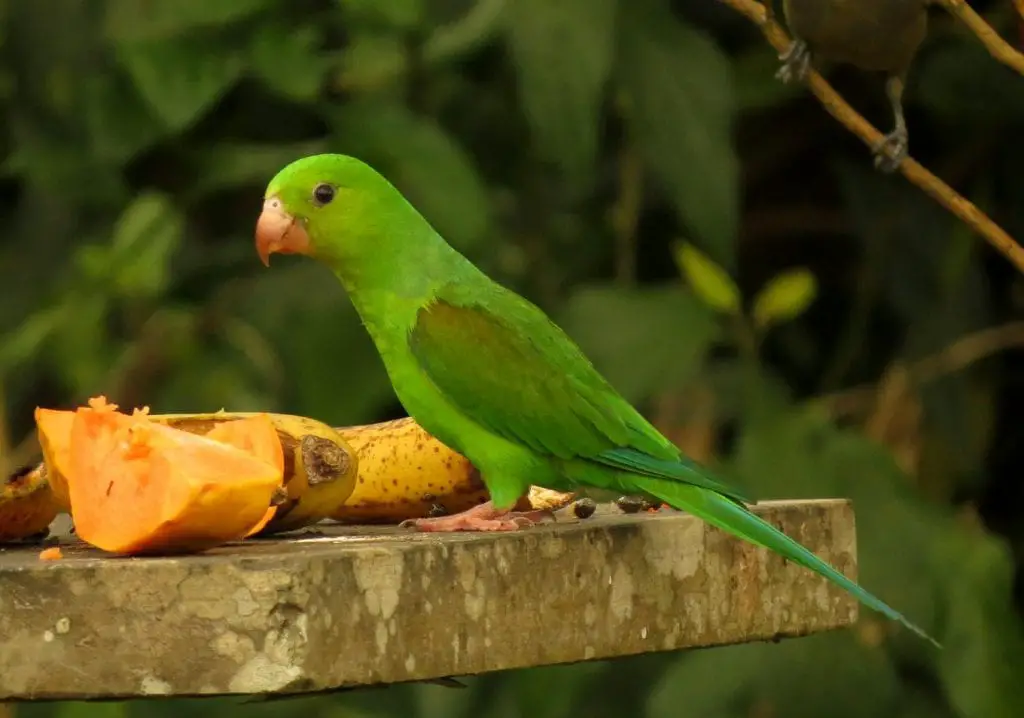
Sleeping Habits
The Plain Parakeets must get enough sleep for them to live healthily. Ideally, these creatures should get at least 10 hours of sleep, counting in their afternoon naps. Parakeets tend to sleep on one leg. Doing so will help them control heat loss occurring in their featherless legs. There is no need to be bothered, though, the four toes are structured well to make sure that they can do good grasp on their cage bars, swing, or perch.
If you see your parakeet closing its eyes, there is a big possibility that your pet is taking its time to rest. However, you must also know that closing their eyes is not always an indication of resting; it may also mean that just feel comfy. Plain Parakeets will also pinch their heads into the feathers. Different from your other pets, these creatures will carry their heads up the entire day. During night-time, Plain Parakeets will sometimes pinch their heads beneath the wing to recline. Doing so will help them fall asleep because the surrounding turns darker and more comfortable. They can also rest their heads.
Development and Reproduction
Breeding happens to be most successful in collective aviaries. Breeding the parakeet in vast bedroom cages can also be done, though not an excellent choice. The average clutch size is 4 to 8 eggs. The newly hatched chicks are completely vulnerable, bared, and blind as they come out. The parents would nourish their chicks in the first 3 weeks. On their 24th day, the chicks will leave the nest and are already capable of feeding themselves. They can then be removed from the cage of the family the moment they reach the age of 1 month.
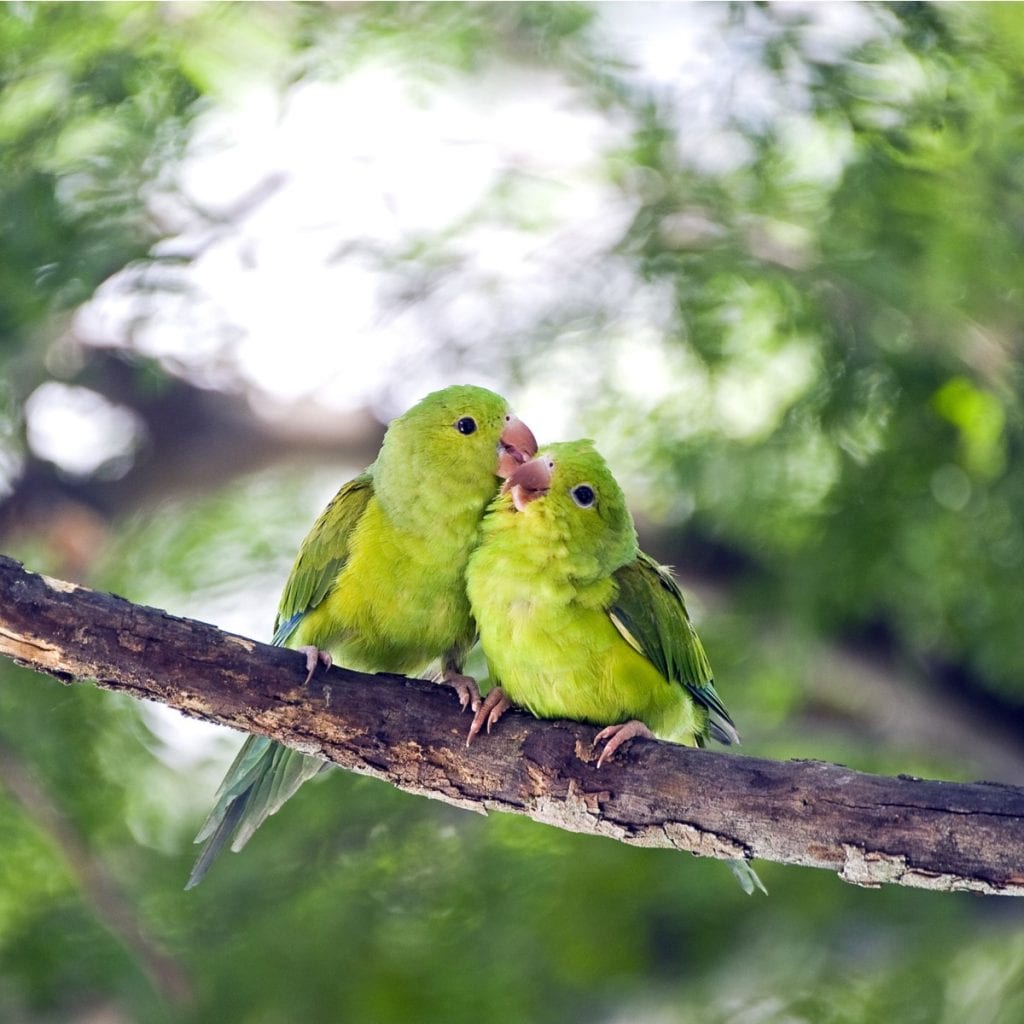
How to Breed
Determining the Sexes
Plain Parakeets are not sexually dimorphic. This means that their sexes cannot be determined visually. If you are not yet certain about the sex of your pet, its gender can be confirmed by a veterinarian through surgery or DNA services.
The benefit of surgical sexing is that it lets the veterinarian check the reproductive abilities as well as the health of other organs. Nevertheless, sexing through surgery commonly involves the use of anesthesia, which can be risky, and infiltrating the body cavity by the body wall and skin may lead to hemorrhage. In certain cases, sex through surgery has been carried out without the use of anesthesia; however, the danger of rupturing the parakeet while it is struggling or moving may exhibit an even higher risk that is carrying out the procedure in a parakeet that is given anesthesia.
Male and female plain parakeets look alike.
Courtship and Mating
While the parakeet demonstrates breeding behavior at a certain period of the year, mating happens when hormones are at the peak. Mating is likely to produce healthy chicks. The actual mating of Plain Parakeets normally last very quickly, but you may observe the actuation heading up to it. The parakeets sit atop each other, with some cooing and billing happening. The female Plain Parakeet may raise her tail or sometimes puke food on the male parakeet – a definite method of parakeet of demonstrating affection. The male Plain Parakeet may begin feeding the female.
Eggs and Incubation
Plain Parakeets have an average clutch size of 4 to 8 eggs. The period of incubation normally takes around 22 to 23 days. Brooding generally starts after laying the last egg. The young chicks hatch within 2 days. The fledging period is normally 7 weeks, where young chicks fed for 2 to 3 weeks after abandoning the nest.
Common Health Problems
Accidents and Injuries
These adventurous and curious parakeets often fall victim to different accidents. They tend to challenge bigger parrots, bigger pets like dogs and cats, which may lead them getting bitten and assaulted. They also experience injuries from their habit of climbing, wandering, and jumping. They enjoy excavating in tight areas, which places them in danger of being strangled by their owners because they enjoy curling up near them, and owners accidentally sit over them.
Avian Gout
Plain Parakeets affected with this illness may experience loss of appetite, ruffled feathers, dehydration, and low growth. Some breeders suggest less protein in their diet to prevent this illness.
Avian Tuberculosis
This disease is serious and may even cause the death of your pet. Parakeets who have avian tuberculosis may gradually lose weight despite their good appetite. They suffer from depression, respiratory difficulty, increased thirst, diarrhea, and decreased production of an egg.
Bacterial Hepatitis
The most common manifestations of bacterial hepatitis among parakeets watery droppings that have minimal to no traces of feces and mostly light green urates. They also lose weight. Some parakeets may vomit food. Parakeets must be evaluated for hydration.
Psittacosis or Chlamydiosis
Common symptoms of psittacosis or chlamydiosis are respiratory issues such as difficulty in breathing, runny nose, sinus infection, or shortness of breathing. There are discharges or swelling of the eye. Parakeets may also experience weakness, weight-loss, fluffed-up feathers, lethargy, and loss of appetite. Chronic manifestations also include acute pneumonia and non-respiratory health issues.
Preventing Illnesses
The ultimate way to prevent illness in your Plain Parakeets is to ensure a good health condition. The cage should be comfortable in size – enough for the parakeet to fly and hop. They should be given a lot of attention because that will make the pet happy and healthy, and thus far from illness. Diet should be varied and balanced. Plain Parakeets need a portion of healthy and nutritive food for them to be healthy.
Further, you can rescue your pet in case you think it is ill. It will be highly beneficial if you become aware of the common symptoms of illnesses. Check the eating habit of your pet. You will know if your pet is healthy if it demonstrates a healthy appetite. Parakeets will normally groom by themselves. If you notice that your pet is not being mindful of its cleanliness, then your pet may be ill. Should an illness attack your pet, the best thing to do is to consult your veterinarian immediately. Although it is always best to do preventions, there are times that you simply cannot control illness from affecting your pet.
Behavior
Plain parakeets are dynamic, playful, sociable, and enjoy climbing in branches. Undeterred by what their name may imply, nothing is boring about these creatures. Small and captivating, these parakeets shall surely fascinate their owners with their sweet and amiable personality. The moment you see their curious and crazy side, you will surely be captivated. They create calls during flight, and these calls are screeches with infrequent rough, two-syllable abrasive notes while resting or feeding.
One of the interesting traits of Plain Parakeets is for them to create adequate levels of noise. With its casual canorous and high-pitched natural call, this creature is not that blaring. These are commonly heard during the time of feeding and other demonstrative instances. Some much-uncomplicated words can be rehashed, although this is not common. Overall, Plain Parakeet is a potential aspirant for a pet bird in an apartment.
These parakeets can easily get along with other breeds of the same size; hence, they are ideal for aviaries.
Owners need to know that these creatures are chewers and fervent flyer. This will demand plenty of space so they can comfortably fly. This will also require an assortment of parrot toys.
Habitat
Cage
The cage should be big enough to provide comfort to your Plain Parakeet. Your pet should have sufficient space to extend its wings after all accessories were already placed inside the cage. Thus, the dimension of the cage is essential. The cage should also have some horizontal bars for the bird to climb on. Although vertical bars are doable, the parakeet will have a more difficult time attempting to move around the cage. Bar spacing is very important since it is a matter of safety. Your pet may get its head stuck on bars, or it can escape from the cage.
Providing your pet some playtime outside the cage is also ideal. However, you do not like him freed without close supervision, getting trapped in curtain cords, squeezed through a hole, or lost underneath the couch.
If setting up space for your Plain Parakeet, always consider what would normally make it feel happy and healthy in the wild. Make some adjustments to attain that in his new home. By doing so, your pet can easily adjust to the new environment.
Perches
Collect different kinds of perches and see to it that you have perched in different texture and width. This will guarantee that the feet of the parakeet will get enough exercise, and its foot is not curled in a single position the entire day. This is not an issue for parakeets in the wild because trees shall always offer branches of numerous sizes.
Utilize a Pedi-perch to assist your pet with their nail trimming. Parakeets in the wild, rub down their nails through plenty of climbing and docking on rough areas. Captive parakeets require more assistance to manage their nails, and the use of pedi-perch would be great. Those described integrate an uneven surface to wear out the nails as well as variable widths to extend the joints in the foot. Use the small size for your Plain Parakeet. However, remember that the use of pedi-perch will not eliminate the requirement for occasional trimming of nails, but it can help.
Rope perches are also good to mention. They come in different lengths and widths and have the superior characteristic of being flexible. They possess a wire core. They can be bent into any structure – either zigzag, right angle, or straight through the cage.
Disseminate the perches inside the cage for the parakeet to readily access its food and water container later and still get sufficient space to hover around.
Toys
Add some toys on the page to prevent your parakeet from feeling bored. Some favorite toys are wooden toys, chewable toys, balls, bells, toys built from ropes, and mirror. Do not clutter the cage with toys because the parakeet may no longer have sufficient space to stretch its wings and move around. Place the toys somewhere the parakeet can easily reach them. You can place them either at the bottom part of the cage, in a perch, or while hanging it on the side.
Food and Water Containers
The cage should have food and water containers, and preferably another extra container. The extra container implies that the parakeet has the option of where to eat, and the parakeet feels safer if they have options. The metabolism of the parakeet is high; thus, it should constantly have access to healthy foods during their active hours. Containers are ideally placed on the side of the cage.
For water, you have the option to use a water bottle or an open bowl. A water bottle may demonstrate the risk of becoming blocked up, while an open bowl can accumulate food, debris, or dust. The best solution is to secure these two in the cage.
Temperature
Plain Parakeets are vulnerable while in the course of acclimation, and extra efforts should be exerted to shield them from cold and wet conditions. The ideal temperature during the period of acclimatization must not go below 75 degrees Fahrenheit. Remember that newly attained parakeets may be vulnerable to intestinal problems. Initially, these parakeets are nervous, but after they are acclimatized, they are expected to be relatively sociable and quiet.
Diet
Plain Parakeets should be given a varied and balanced diet. Their primary diet should be a superior-quality dry parrot mix. The best kinds of parrot mix have nutritive super-foods like herbs and bee-pollen, grains, veggies, plenty of various fruits – entirely human grade. Germinated or sprouted seeds are commonly more accepted over fresh vegetables and fruits by parakeets who are seed fanatics.
Sprouted seeds are more beneficial while the sprouting modifies and improves the nutritive quality and worth of grains and seeds. These seeds have lower fat because the sprouting process makes use of the fat to begin the growing process of the seed, hence, lowering the fat kept in the seeds. Another reason why it is good to provide your parakeet some sprouted seeds is that they help neutralize the diet by contributing a nutritive amount of rich in vegetable vitamins, proteins, chlorophyll, enzymes, and minerals. Drenched and sprouted oil seeds such as rapeseeds and niger are abundant in carbohydrates and protein, while starch seeds like millets and canary and abundant in carbohydrates but have lower protein. It is a valuable food; nevertheless, it is particularly essential for molting or breeding birds. Germinated seeds also make ideal breeding and weaning food since the supple shell is more manageable to crash by chicks and makes them familiar with the seed texture.
In the wild, these creatures feed on palm fruits. They also disperse these fruits. They also eat seeds, flowers, algae, minerals and grit, insects, and other fruits such as figs and berries.
How to Care for Plain Parakeet
To make your Plain Parakeet contented and happy, you should give it ample spaces and various perches, but most importantly – your love and affection. Frequently talk to your parakeet. Make your pet familiarize your voice. Feed your pet with a nutritious diet.
Parakeets can sometimes be loud and are firstly shy. Nevertheless, they soon turn imparting. It is suggested to give your pet a regular stock of fresh twigs. They occasionally bathe, however, a hollow dish must be secured daily. This is specifically necessary during the season of breeding.
Availability – Where to Get One
If you are planning to get a Plain Parakeet, you may consider checking on pet stores for the best choices. A lot of bird breeders also sell Plain Parakeets. Nevertheless, remember to always examine the condition of the parakeet before getting it. The surest way of getting this pet is to transact in a reliable seller.
The key here is not to buy in a rush. A lot of sellers are recognized to be reliable and offer healthy parakeets. If you do not consider being careful in buying your parakeet, you might be given a parakeet that is ill or unsuitable for handling. If you drop by on any store to choose for a parakeet that stores the birds in congested, unclean cages, you may consider shopping somewhere else. Parakeet exposed to this kind of environment is likely to get diseases.
FAQs
Is there a tendency for my Plain Parakeet to overeat?
Yes. If you serve your Plain Parakeet the same pellets or seed mix every day, your pet can get disinterested and overheat because there is nothing else to take up its mind. Your pet can also be inclined to overeating if you serve it with a seed-based diet. You should know that seeds contain high fat and low protein content compared to pellets; thus, even a little quantity is already rich in calories.
Is it not harmful to the kids?
These creatures are friendly. You can exposed Plain Parakeets to your children because they are not potentially harmful. However, it is always recommended that you also supervise your kids while playing with the pet.
Can I give my Plain Parakeet any kind of toy?
You cannot give your Plain Parakeet toys with small components and parts. These may impose a risk of choking in your pet. You must also not give your pet any toys that have zinc or lead plating. Also, avoid toys with flakes or bits of plastic, which can be chewed off and absorbed. Always be mindful of your choices of toys. Make sure that they will not cause harm to your pet.
How can I tell if my pet parakeet is sick?
If you notice your Plain Parakeet to be billowed or has been sleeping for a very long time, there is a big chance that your pet is not feeling well. Some parakeets try to keep their illnesses until they are not able to manage it anymore. It would be best if you make yourself familiar with the common symptoms of illness. The earlier you can detect the illness of your pet, the higher the chance of you saving your pet from the risk of complication or death. If you think that your pet is suffering from a disease, the best thing to do is to bring it to the nearest veterinarian. You cannot take the risk of assuming your pet will eventually recover from its current condition. You have to seek medical assistance from your trusted veterinarian to confirm the current condition of your pet.
Toenails are bleeding after I cut them, what should I do?
Try putting a small quantity of cornstarch to hold back the bleeding. If the bleeding will still not stop, immediately bring your pet to a veterinarian. Put in mind that even a few drops of blood from your parakeet can be critical.
What does it mean when a female parakeet is piercing holes in the eggs?
Female parakeets will normally do that if she is calcium deficient. Get your pet a cuttlebone and place it inside the cage close to a mirror. Also, give your pet some vitamin drops and mix them in the birdseed.
Is it advisable to let my Plain Parakeet out?
Allowing your Plain Parakeet to go out is recommended. It needs some space to fly and extend its wings. If you intend to regulate where they proceed if they are out, provide them a captivating place for playtime. Also, your supervision is highly required, especially if your pet is out of the cage.

